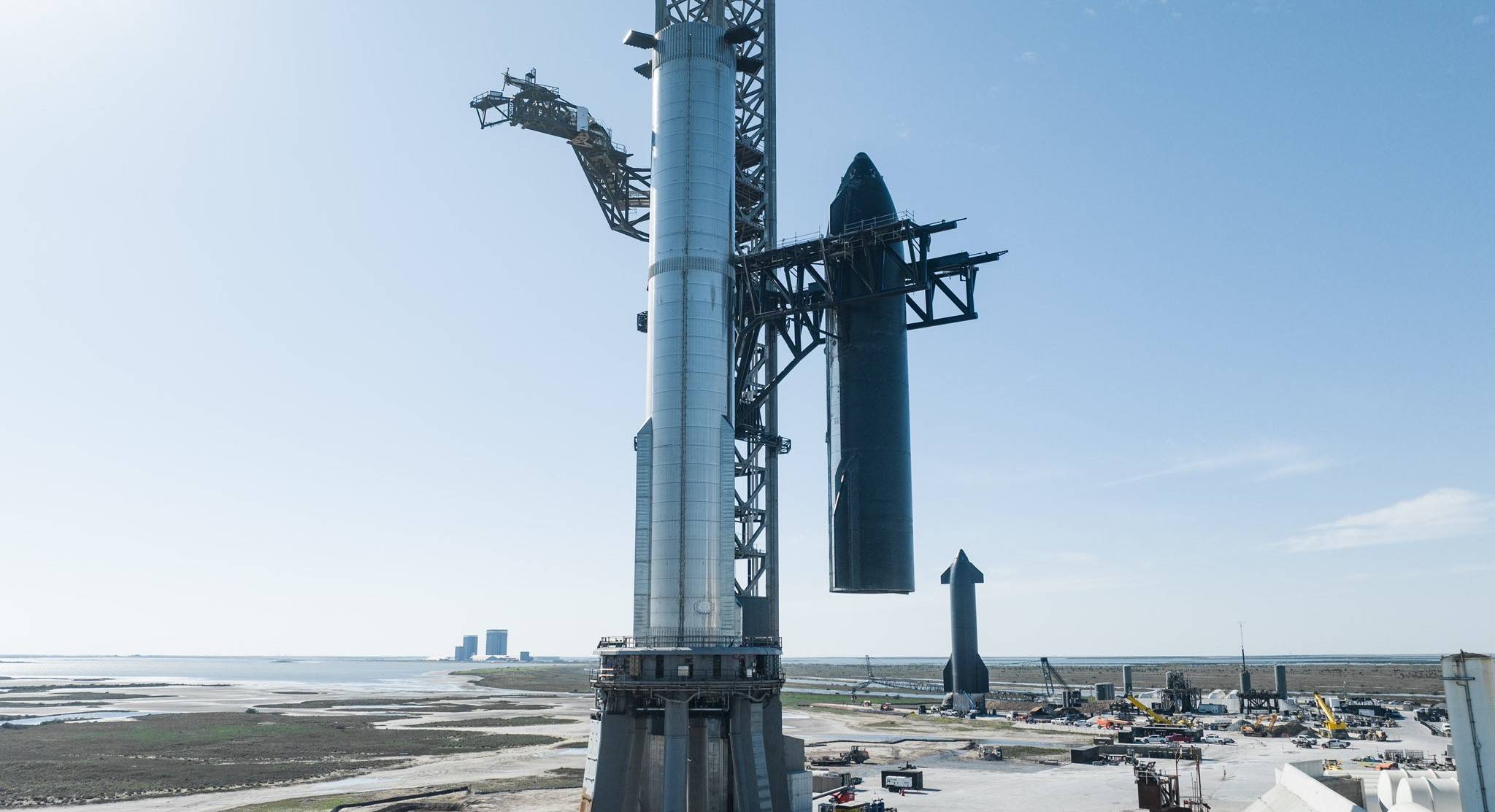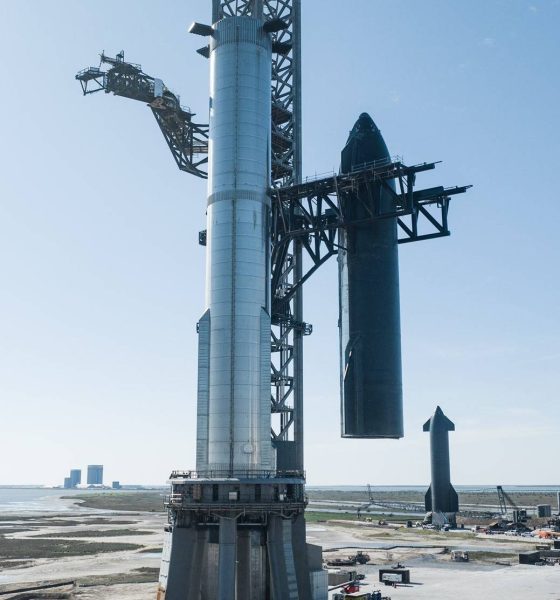

News
SpaceX sets stage for Starship booster’s first 33-engine static fire
SpaceX has set the stage for a record-breaking Starship booster static fire after the rocket completed a complex fueling test and launch rehearsal earlier this week.
On January 25th, a tower the size of a skyscraper activated a pair of giant mechanical arms to disassemble the largest rocket ever built. The arms carefully grabbed Starship using hard points under its flaps and lifted the 50-meter-tall second stage and spacecraft off of Super Heavy Booster 7. Nicknamed Mechazilla, the robot lowered the hundred-ton (~220,000+ lbs) vehicle hundreds of feet onto a waiting stand and eventually let go. On January 26th, SpaceX transported Ship 24 back to its Starbase, Texas factory for finishing touches.
Booster 7 remained installed on Starbase’s donut-shaped orbital launch mount, which uses clamps and umbilicals to hold Starship in place and power, fuel, and pressurize Super Heavy. In theory, the next time Booster 7 leaves that launch mount, it will do so under its own power. But first, SpaceX must ensure that that unprecedented power can be controlled (and survived).
The update that's rolling out to the fleet makes full use of the front and rear steering travel to minimize turning circle. In this case a reduction of 1.6 feet just over the air— Wes (@wmorrill3) April 16, 2024
This, unfortunately, is far from the first iteration of this story. SpaceX has been seemingly close to the milestone at many points over the last year and a half. In September 2021, for example, CEO Elon Musk reported that Super Heavy Booster 4 would attempt the first static fire on Starbase’s orbital launch mount later that month. Eleven months later, Super Heavy Booster 7 gave the OLM its inaugural static fire test – albeit with just one of its 33 engines.
In the months following that static fire, Booster 7 completed another single-engine test, a two-engine test, a seven-engine test, a fourteen-engine test, and a long-duration eleven-engine test. All of that slow and steady testing has been fairly successful and caused no major damage to the rocket or pad. But five months after it began, SpaceX has never ignited more than 14 – 42% – of Super Heavy’s 33 Raptor engines at once. That must change before SpaceX can gain enough confidence in Starship for (and convince the FAA to license) an orbital launch attempt.
During Super Heavy B7’s 14-engine static fire, the booster could have produced up to 3220 tons (7.1 million pounds) of thrust. When it ignites all 33 available engines for the first time, its maximum thrust could leap to 7590 tons (16.7 million pounds), beating the next most powerful rocket in history – the Soviet N1 – by nearly 60%. In other words, SpaceX will be attempting something unprecedented in rocketry. Success is far from guaranteed and the worst possible failure mode could almost entirely destroy Starship’s only finished orbital launch site, explaining SpaceX’s unusual caution.
On January 23rd, Ship 24 and Booster 7 completed Starship’s first full wet dress rehearsal (a fueling and launch rehearsal test) on the first try – an extremely impressive achievement for any rocket, let alone the largest in history. With that combined test out of the way, the only unprecedented test standing between Starship and its first orbital launch attempt is a 33-engine Super Heavy static fire.
To reduce risk, Ship 24 was removed from Booster 7. Back at the factory, SpaceX needs to close a few gaps left in its heat shield, and will likely also conduct careful inspections to ensure that the Starship is ready for flight. Unburdened of Ship 24, Booster 7 may finally be on the cusp of the most challenging ground test in Starship and SpaceX history. SpaceX has scheduled 12-hour road closures that could be used for that purpose as early as January 30th, 31st, and February 1st.
Those road closures could be used for Ship 25 static fire testing instead of or in addition to Booster 7. The Super Heavy is also missing an important hydraulic power unit (HPU) that was removed before the wet dress rehearsal. It’s unclear if static fire testing can be conducted without that HPU (one of two), why it was removed, or how long replacing it will take, adding more uncertainty. Nonetheless, it still appears that SpaceX is no more than a few weeks away from Starship’s first 33-engine static fire attempt.

News
Tesla FSD fleet is nearing 7 billion total miles, including 2.5 billion city miles
As can be seen on Tesla’s official FSD webpage, vehicles equipped with the system have now navigated over 6.99 billion miles.

Tesla’s Full Self-Driving (Supervised) fleet is closing in on almost 7 billion total miles driven, as per data posted by the company on its official FSD webpage.
These figures hint at the massive scale of data fueling Tesla’s rapid FSD improvements, which have been quite notable as of late.
FSD mileage milestones
As can be seen on Tesla’s official FSD webpage, vehicles equipped with the system have now navigated over 6.99 billion miles. Tesla owner and avid FSD tester Whole Mars Catalog also shared a screenshot indicating that from the nearly 7 billion miles traveled by the FSD fleet, more than 2.5 billion miles were driven inside cities.
City miles are particularly valuable for complex urban scenarios like unprotected turns, pedestrian interactions, and traffic lights. This is also the difference-maker for FSD, as only complex solutions, such as Waymo’s self-driving taxis, operate similarly on inner-city streets. And even then, incidents such as the San Francisco blackouts have proven challenging for sensor-rich vehicles like Waymos.
Tesla’s data edge
Tesla has a number of advantages in the autonomous vehicle sector, one of which is the size of its fleet and the number of vehicles training FSD on real-world roads. Tesla’s nearly 7 billion FSD miles then allow the company to roll out updates that make its vehicles behave like they are being driven by experienced drivers, even if they are operating on their own.
So notable are Tesla’s improvements to FSD that NVIDIA Director of Robotics Jim Fan, after experiencing FSD v14, noted that the system is the first AI that passes what he described as a “Physical Turing Test.”
“Despite knowing exactly how robot learning works, I still find it magical watching the steering wheel turn by itself. First it feels surreal, next it becomes routine. Then, like the smartphone, taking it away actively hurts. This is how humanity gets rewired and glued to god-like technologies,” Fan wrote in a post on X.
News
Tesla starts showing how FSD will change lives in Europe
Local officials tested the system on narrow country roads and were impressed by FSD’s smooth, human-like driving, with some calling the service a game-changer for everyday life in areas that are far from urban centers.

Tesla has launched Europe’s first public shuttle service using Full Self-Driving (Supervised) in the rural Eifelkreis Bitburg-Prüm region of Germany, demonstrating how the technology can restore independence and mobility for people who struggle with limited transport options.
Local officials tested the system on narrow country roads and were impressed by FSD’s smooth, human-like driving, with some calling the service a game-changer for everyday life in areas that are far from urban centers.
Officials see real impact on rural residents
Arzfeld Mayor Johannes Kuhl and District Administrator Andreas Kruppert personally tested the Tesla shuttle service. This allowed them to see just how well FSD navigated winding lanes and rural roads confidently. Kruppert said, “Autonomous driving sounds like science fiction to many, but we simply see here that it works totally well in rural regions too.” Kuhl, for his part, also noted that FSD “feels like a very experienced driver.”
The pilot complements the area’s “Citizen Bus” program, which provides on-demand rides for elderly residents who can no longer drive themselves. Tesla Europe shared a video of a demonstration of the service, highlighting how FSD gives people their freedom back, even in places where public transport is not as prevalent.
What the Ministry for Economic Affairs and Transport says
Rhineland-Palatinate’s Minister Daniela Schmitt supported the project, praising the collaboration that made this “first of its kind in Europe” possible. As per the ministry, the rural rollout for the service shows FSD’s potential beyond major cities, and it delivers tangible benefits like grocery runs, doctor visits, and social connections for isolated residents.
“Reliable and flexible mobility is especially vital in rural areas. With the launch of a shuttle service using self-driving vehicles (FSD supervised) by Tesla in the Eifelkreis Bitburg-Prüm, an innovative pilot project is now getting underway that complements local community bus services. It is the first project of its kind in Europe.
“The result is a real gain for rural mobility: greater accessibility, more flexibility and tangible benefits for everyday life. A strong signal for innovation, cooperation and future-oriented mobility beyond urban centers,” the ministry wrote in a LinkedIn post.
News
Tesla China quietly posts Robotaxi-related job listing
Tesla China is currently seeking a Low Voltage Electrical Engineer to work on circuit board design for the company’s autonomous vehicles.

Tesla has posted a new job listing in Shanghai explicitly tied to its Robotaxi program, fueling speculation that the company is preparing to launch its dedicated autonomous ride-hailing service in China.
As noted in the listing, Tesla China is currently seeking a Low Voltage Electrical Engineer to work on circuit board design for the company’s autonomous vehicles.
Robotaxi-specific role
The listing, which was shared on social media platform X by industry watcher @tslaming, suggested that Tesla China is looking to fill the role urgently. The job listing itself specifically mentions that the person hired for the role will be working on the Low Voltage Hardware team, which would design the circuit boards that would serve as the nervous system of the Robotaxi.
Key tasks for the role, as indicated in the job listing, include collaboration with PCB layout, firmware, mechanical, program management, and validation teams, among other responsibilities. The role is based in Shanghai.
China Robotaxi launch
China represents a massive potential market for robotaxis, with its dense urban centers and supportive policies in select cities. Tesla has limited permission to roll out FSD in the country, though despite this, its vehicles have been hailed as among the best in the market when it comes to autonomous features. So far, at least, it appears that China supports Tesla’s FSD and Robotaxi rollout.
This was hinted at in November, when Tesla brought the Cybercab to the 8th China International Import Expo (CIIE) in Shanghai, marking the first time that the autonomous two-seater was brought to the Asia-Pacific region. The vehicle, despite not having a release date in China, received a significant amount of interest among the event’s attendees.








